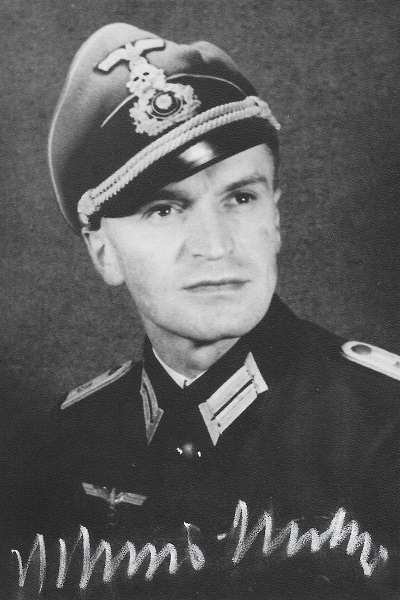Schmidt, Hellmut (Panzer-Regiment 10)
- Date of birth:
- February 1st, 1913 (Lüben/Silesia, Germany)
- Date of death:
- January 9th, 1996 (Essen/Northrhine-Westphalia, Germany)
- Nationality:
- German (1933-1945, Third Reich)
Biography
Promotions:
March 1st, 1943: Hauptmann.
Career:
April 1st, 1940: Zugführer, Panzer-Abteilung 67;
January 1st, 1941: Zugführer, III. Abteilung, Panzer-Regiment 10;
August 13th, 1941: Zugführer, Panzer-Ersatz-Abteilung 10;
October 8th, 1941: Zugführer, III. Abteilung, Panzer-Regiment 10;
December 1st, 1941: Kompanieführer, III. Abteilung, Panzer-Regiment 10;
July 2nd, 1942: Führer, Stabskompanie, Panzer-Regiment 10;
January 27th, 1943: Führer, 1. Kompanie, Panzer-Regiment 10;
September 30th, 1943: Panzer-Ersatz und Ausbildungs-Abteilung 10;
May 1st, 1944: Führer, I. Abteilung, Panzer-Regiment 10.
Do you have more information about this person? Inform us!
- Period:
- Second World War (1939-1945)
- Unit:
- Zugführer, Panzer-Abteilung 67, 8. Panzer-Division, Heer
- Awarded on:
- June 1st, 1940
Silver version.
- Period:
- Second World War (1939-1945)
- Unit:
- Zugführer, Panzer-Abteilung 67, 8. Panzer-Division, Heer
- Awarded on:
- June 22nd, 1940
- Period:
- Second World War (1939-1945)
- Unit:
- Zugführer, III. Abteilung, Panzer-Regiment 10, 8. Panzer-Division, Heer
- Awarded on:
- July 12th, 1941
- Period:
- Second World War (1939-1945)
- Unit:
- Kompanieführer, III. Abteilung, Panzer-Regiment 10, 8. Panzer-Division, Heer
- Awarded on:
- December 24th, 1941
- Period:
- Second World War (1939-1945)
- Unit:
- Führer, Stabskompanie, Panzer-Regiment 10, 8. Panzer-Division, Heer
- Awarded on:
- August 12th, 1942
- Period:
- Second World War (1939-1945)
- Rank:
- Hauptmann (Captain)
- Unit:
- Führer, 1. Kompanie, I. Abteilung, Panzer-Regiment 10, 8. Panzer-Division, Heer
- Awarded on:
- August 29th, 1943
- Period:
- Second World War (1939-1945)
- Rank:
- Hauptmann (Captain)
- Unit:
- Führer, 1. Kompanie, I. Abteilung, Panzer-Regiment 10, 8. Panzer-Division, Heer
- Awarded on:
- September 16th, 1943
Later, as the Soviets occupied Knjaginino, the Kompanie would stand alone in the midst of the fleeing German infantry. Hauptmann Schmidt himself wrote the following account of what happened next…
“In light of our outstanding slope position, the order to fire was given when the enemy was at a range of 800-900 metres. The first salvo from our 9 Panzers achieved 6 hits! The Russians were dumfounded and unsure of where they had been attacked from, and they therefore began to turn around. But this only meant that our fire would be even more effective against the side armour of the T-34 and 52 ton KV-2 tanks…
An infantry officer beside my Panzer spotted newly appearing tank targets for my gunner, Unteroffizier Blass…
Unteroffizier Blass was able to nock up 6 tank kills…
I must give particular attention to the left group of a Leutnant. He had the additional mission of holding open the corduroy road, and even though it was his first battle he proved up to the task of carrying out this security mission with his group. By around 11:00 the Russians’ brigade-strength armoured attack had been completely crushed.”
The 9 Panzers of Hauptmann Schmidt destroyed 35 T-34s and 2 KV-2s during this latter engagement, all without any friendly losses. The Germans later confirmed that, out of 50 claimed tanks destroyed, the Kompanie had destroyed 38 T-34 tanks and 4 KV-2s (though it’s quite likely this actually refers to KV-1s) on this day.
Hauptmann Schmidt was later awarded the Knight’s Cross for his actions on this day.
- Period:
- Second World War (1939-1945)
- Rank:
- Hauptmann (Captain)
- Unit:
- Führer, 1. Kompanie, I. Abteilung, Panzer-Regiment 10, 8. Panzer-Division, Heer
- Awarded on:
- October 21st, 1943
According to the "beurteilung", the awarding took place on October 23rd.
Sources
- Photo 1: Known to STIWOT
- - HAUPT, W., Die 8. Panzer-Division im Zweiten Weltkrieg, Podzun-Pallas, 1987.
- PATZWALL, K. & SCHERZER, V., Das Deutsche Kreuz 1941-1945, Verlag Klaus D. Patzwall, Norderstedt, 2001.
- Beurteilung Hauptmann, 10.7.1944










